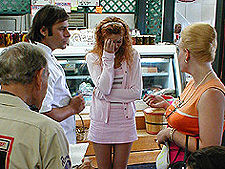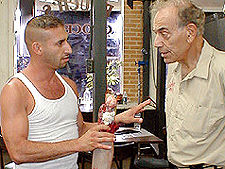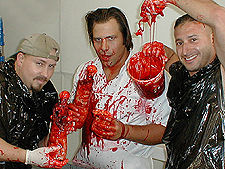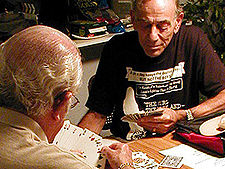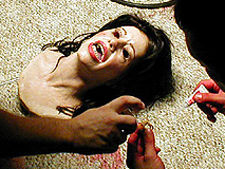August 9, 2001
 Laying his carving knife aside, Fuad Ramses III gleefully slips his fingertips into the gaping wound of a buxom corpse and wrenches free her kidney. “Yes!,” the voice of director Herschell Gordon Lewis booms. “Now, stroke it. Think ‘I LOVE YOU!’ … Get some more glop!” Fuad tenderly caresses the dripping flesh while the stench of slaughterhouse intestines hangs in the air, choking the resolve of a camera assistant who staggers out of the cramped room in disgust. “Cut!,” Lewis exclaims. “That’s it! That’s what they’ll be talking about! That’s our tongue scene!”
Laying his carving knife aside, Fuad Ramses III gleefully slips his fingertips into the gaping wound of a buxom corpse and wrenches free her kidney. “Yes!,” the voice of director Herschell Gordon Lewis booms. “Now, stroke it. Think ‘I LOVE YOU!’ … Get some more glop!” Fuad tenderly caresses the dripping flesh while the stench of slaughterhouse intestines hangs in the air, choking the resolve of a camera assistant who staggers out of the cramped room in disgust. “Cut!,” Lewis exclaims. “That’s it! That’s what they’ll be talking about! That’s our tongue scene!”
He’s absolutely right. In 1963, Lewis and partner David F. Friedman, already accomplished exploiteers, accidentally created an entirely divergent film genre with the first Blood Feast, and in so doing, became the Godfathers of Gore. The flick’s most notorious scene was that of a crazed Fuad Ramses reaching into the mouth of a screaming coed and ripping out her tongue. Never had anyone dared to exploit graphic gore in vivid color with lingering crimson closeups such as these. It’s as shocking today as it was nearly 40 years ago, and in this current climate of censorship, maybe more so. Lewis and Friedman parted company after Color Me Blood Red the third and final film of their unintentional Blood Trilogy. Friedman went to Hollywood, and Lewis continued making exploitation pictures of all stripes on his own. But in 1972, the year I was born, Herschell made what he’d later assume was his swan song — The Gore Gore Girls. Filmmaking became a closed chapter in his life and he’d gone on to spend the next three decades establishing himself as the leading authority on direct marketing and advertising with more than 15 books in print. But in the early-’80s a new generation of fans began to discover his pictures. He and Friedman would be honored at film festivals. Retrospective articles and books would chronicle their exploits. And Lewis joked that it seemed everyone had half-pitched the idea of making a Blood Feast sequel, but the notions only amounted to industry pleasantries. That’s until Jacky Lee Morgan and W. Boyd Ford made a pilgrimage to see Mr. Lewis at his Fort Lauderdale home while they were in the neighborhood during production of Larry Clark‘s Bully. Inevitably, talk got around to Blood Feast, and Herschell confided in them that he’d like to return to filmmaking if the right opportunity presented itself. Ford immediately set to work on a script and Morgan began to seriously court the director.
Earlier this year, I was just about to conclude a telephone interview with Mr. Lewis about his work’s digital canonization, when he cracked me over the skull with astonishing news. After nearly 30 years, he would return to direct Blood Feast 2: All U Can Eat. He put me in contact with Morgan, who I was overjoyed to find was as rabid about Lewis and Friedman as myself. We kept in touch during the weeks leading up to production and then my dream came true. It became my great privilege to be welcomed onto the set of this historic sequel.
Sunday, August 5, 2001
3 p.m.
Jacky just introduced me to Dave Friedman — a walking oracle of exploitation history. Dave’s looking for his buddy Lee Frost who’s also due to visit the set. They worked together on several pictures, my favorite of which is his rougher roughie The Defilers. When I point to his spanking scene as being particularly inspired, he tells me with transparent pride, that he’s actually received fan mail from spanking enthusiasts regarding it. But the 77-year-old carny is quick to remind me that Scum of the Earth! — which he and Lewis made together — is really the defining flick of the genre.
 Mr. Friedman ushers me over to meet Herschell. While shaking his hand I try not to gush, but do anyway. It’s like meeting Santa Claus when you’re six years old. He remembers our interview, and invites me inside Rauch’s Grocery which has been overrun by a crew of 20-somethings scrambling in preparation for the next scene. On most days, this rustic little store serves the fine citizenry of Abita Springs, Louisiana, but today it’s been transformed into Fuad Ramses Exotic Catering Shop. A fog machine fills the air with a thin haze that catches the light in perfect shafts through the boarded up windows. On the camera monitor, it really DOES look like the shop’s been forgotten for nearly 40 years. Herschell is anxious to move on to the next shot. He’s already covered the exterior and grandson Fuad’s tentative entrance with his pet skunk Fluffy in tow. While the crew continues, Herschell asks how he can be of service. I tell him my just being allowed to observe is more than sufficient. He nods, then glares toward the direction of the camera, which is being prepared for a tracking shot. He’s politely annoyed by the delay, but opts to chat with me for a moment more before rattling the appropriate cages. “I don’t think a picture has been done quite like this before. It’s a parody, up until the gore, and that’s NO parody!,” he explains. “I think it’ll be very unsettling for the audience.” His voice trails off. They’re ready. The 72-year-old director springs into action and within moments has the shot he wants. “Everyone looks good in silhouette,” he says.
Mr. Friedman ushers me over to meet Herschell. While shaking his hand I try not to gush, but do anyway. It’s like meeting Santa Claus when you’re six years old. He remembers our interview, and invites me inside Rauch’s Grocery which has been overrun by a crew of 20-somethings scrambling in preparation for the next scene. On most days, this rustic little store serves the fine citizenry of Abita Springs, Louisiana, but today it’s been transformed into Fuad Ramses Exotic Catering Shop. A fog machine fills the air with a thin haze that catches the light in perfect shafts through the boarded up windows. On the camera monitor, it really DOES look like the shop’s been forgotten for nearly 40 years. Herschell is anxious to move on to the next shot. He’s already covered the exterior and grandson Fuad’s tentative entrance with his pet skunk Fluffy in tow. While the crew continues, Herschell asks how he can be of service. I tell him my just being allowed to observe is more than sufficient. He nods, then glares toward the direction of the camera, which is being prepared for a tracking shot. He’s politely annoyed by the delay, but opts to chat with me for a moment more before rattling the appropriate cages. “I don’t think a picture has been done quite like this before. It’s a parody, up until the gore, and that’s NO parody!,” he explains. “I think it’ll be very unsettling for the audience.” His voice trails off. They’re ready. The 72-year-old director springs into action and within moments has the shot he wants. “Everyone looks good in silhouette,” he says.
Then the reset process begins again. But this time he has actors to rehearse. Our star is J.P. Delahoussaye, but to Herschell, he’s simply “Fuad.” They’re joined by Detective Myers (Mark McLaughlan) and the three briefly block the scene, rehearse the dialogue and soon action is called. Another scene, more dialogue. It becomes clear that these sorts of sequences aren’t what the director enjoys most. When Fuad breaks out of a scene and admits he flubbed a line, Herschell sarcastically barks, “No kidding, Dick Tracy.” But no time is spent belaboring the error. Once again the camera is rolling and Mr. Lewis is pleased with what he’s seeing in the monitor. This take will do.
5 p.m.
I can’t stand it anymore. I geek out and ask Mr. Friedman to sign my Blood Feast and Two Thousand Maniacs! posters. He graciously agrees and insists on unfolding them to assess what he soon calls their impressive condition. Those around us stare at the blood-red letters which scream “GRUESOMELY STAINED IN BLOOD COLOR!” and “MADMAN CRAZED FOR CARNAGE!” Friedman then calls Herschell over who becomes equally mesmerized. I tell Mr. Lewis that I have something special I’d like him to sign as I unfold an original Living Venus one-sheet — the first picture he ever directed (1960). He sits back and looks at it for awhile with a smile on his face. As he signs it, he thanks me for sharing it with him, “It really is like seeing a long lost child.”
Throughout the day, the occasional bewildered customer wanders into Rauch’s looking to buy a tub of nightcrawlers, a beer, or a few slices of smoked ham. Some are annoyed, others are curious as to what the devil’s going on. “We’re making a movie,” someone inevitably answers politely. When pressed, “a horror movie.” Curiously, that distinction garners a cautious acknowledgement and a subtle, but hasty exit. Then there’s the repeated shhhushing of the location. Before a scene can be shot, a mad circuit must be made of all the store’s noise-generating doodads. The ice machines must be unplugged. Several oscillating fans are switched off. And when the antiquated air conditioner rumbles to a halt one realizes how LOUD the fool thing is. With that, the sticky August heat just hangs around the sweating crew who take a collective deep breath before the camera rolls, lest their whispers be picked up on the sound recording.
7 p.m.
Lunch! It’s fried chicken, Herschell’s favorite. In the old days, he’d angled a deal with Kentucky Fried Chicken to supply meals for his crew, in exchange for product placement, which was then a foreign concept. In fact, Colonel Sanders himself appears in Blast-Off Girls (1967). I let the others have their fill before snagging a piece or two for myself. While scarfing down his meal, McLaughlan regales me with stories about working with the great Tobe Hooper on Crocodile. Mark played Brady Turner who, with his buddies, runs afoul with a super-sized beastie during spring break. He tells me there was a mutiny of sorts during shooting, and the whole company was moved to Mexico to finish the film. There he was confronted by tarantulas and Mexican strippers on a regular basis. We talk about Tobe, who I expect to meet at Fangoria next week, and Mark is anxious to send his regards. He’s an upbeat guy. Very funny on screen, as he seems to channel Don Knotts as Barney Fife. His character has the same comic befuddlement and fixation with his sidearm.
8:30 p.m.
There’s been an unprecedented delay because the film supplier is now 12 hours overdue with its delivery. But Morgan has spent the afternoon working the phones and at last the needed film is on set, loaded and ready to go. Mrs. Lampley (Melissa Morgan) and her bride-to-be daughter Tiffani (Toni Wynne) have come to the shop to discuss catering arrangements for their wedding reception. During a rehearsal, Herschell sternly reminds Fuad, “What happened to your limp?!” Fuad begins dragging his foot as he’d done perfectly during the previous walk-through. Lewis himself is limping, as his knee is giving him fits. An extremely active man, he chalks it up to being off his morning exercise routine, “I haven’t played tennis since I’ve been down here.” He ignores it, and keeps herding the actors and crew through these dialogue-heavy scenes. The pressure mounts most on Fuad, who struggles to keep his lines straight. Herschell mutters with a half-smile, “In a perfect world actors would know what they’re doing.”
9:50 p.m.
Finally, something different, and Mr. Lewis is clearly relieved. Fuad is about to split Mrs. Lampley’s head open with a cognac bottle when he’s startled and the bottle is dashed to bits on the floor. The camera has been positioned at ground level to catch the impact. Assistant director Jimi Woods, wearing safety glasses, has clambered atop a counter to drop the bottle, but one of the crew GASPS just as the glass shatters — ruining the take. Herschell looks to the sound man in disbelief. They prepare for another take. Before that, though, someone must run next door to Ol’ Rosie’s Bar and plead with them to keep their Sunday-night revelry down. Take two begins, and this time someone involuntarily yelps “Ohhhh!” at impact. Herschell almost jumps out of his skin. All day he’s wrestled to keep things moving. To shoot and move on. Here an incredibly simple shot is on its third take, and to make matters worse, they’re running out of bottles. Fortunately, the third time’s the charm.
Midnight
Here’s why I came. To witness the Godfathers of Gore at work. This scene calls for Fuad to do some unpleasant things to a severed arm. As Herschell discusses the sequence with FX man Joe Castro, he’s expressly clear he wants GOUTS of blood to fly into the air along with bits of tissue and bone. The demeanor of this regal man visibly changes. Despite the hour, and the obvious frustration of the day, Lewis is like a boy who’s just about to light a fistful of Roman candles. While the scene is readied, I introduce myself to Fuad, er, J.P. who admits, “They’re killing me! I haven’t been off the set at all tonight.” I sort of look at him. Clearly, he hasn’t quite grasped that he’s making cinematic history here. It dawns on me how completely alien this whole movie is to him and a part of me feels sorry for him. The poor fella really had NO idea what he was getting himself into. I assure him that his hard work is evident from what I’ve observed so far, and then side-step away.
Soon the camera rolls. It’s hard to decide what to watch, the gorrific mayhem of Fuad being drenched in blood and goo by two exuberant FX maniacs, or the orchestrators of it all, Lewis and Friedman, who are GLUED to the monitor and grinning from ear to ear. Afterward, Herschell turns to a dripping Delahoussaye and beams, “Fuad deserves a round of applause for that one!” And we all join in applauding him. But a few moments later, as the setup is being done for the final scene of the night, Fuad erupts. He’s been left covered in blood. His face is drenched, his eyes stinging, and none of our praise matters in the least. He howls about never being given a towel, about being stuck on set all day, and about not having enough time to rehearse his lines. Herschell is immediately angry, but thinks better of it. Everyone eases away while actor and director have a heart-to-heart. I can’t help but eavesdrop. Herschell reminds J.P. that Fuad is the whole picture, he’s the star, and that they’ll make it through the night, if he can just keep cool for this last scene. Within seconds they’re both smiling again.
12:45 a.m.
Lewis is amused. He just added the word “crunchy” to a bit of dialogue they’re about to do. Fuad is being questioned by Detectives Myers and Loomis (John McConnell) during which he feeds them from a tray of freshly-prepared lady finger sandwiches. Uh huh, you guessed it. When Myers is shouting at Fuad, he absently waves a half-eaten finger in his face, which Herschell finds absolutely riotous. “There’s method acting if I ever saw it!,” he laughed.
1:30 a.m.
A man of his word, once the scene was wrapped, Herschell released Fuad into the night where I last saw him frantically wiping his face with a towel. Lewis and Friedman were then driven back to their Holiday Inn home away from home in Covington, Louisiana.
Monday, August 6, 2001
1:00 p.m.
I’ve decided to drop in on the goddess Ishtar in Mandeville, Louisiana. She spawned all the unpleasantness of the original film as grandpa Fuad prepared a sacrificial blood feast in her honor. No doubt her influence will impact negatively on his grandson as well. I find her standing alone in a room clutching her nekkid bosom. She was fashioned from Styrofoam and papier-mache by Penelope Helmer and stands nearly six feet tall. The sight of her is awe inspiring.
2:00 p.m.
I have arrived at a modest two-story home in Lacombe, Louisiana. This location will serve as Laci Hundie’s (Michelle Miller) apartment for the day. But first, we caravan over to a wooded area where Fuad will dump the body of his latest victim. The camera has been hauled into the middle of a lonely black-top road and Herschell is explaining the action to Fuad. He’ll back the truck off the road, park, get out and dispose of the corpse. No problem. In place of a living actress is Morgan’s long-time inflate-a-date wrapped in a shower curtain. During the walk-through, Fuad hurls the light-as-air doll into the air, not quite “selling” the weight of nubile flesh. I’m so eager to be killed in a Herschell Gordon Lewis picture, that I actually consider volunteering to wear the dress and wig myself. Thankfully, I bury that impulse. Time is short, as the clouds keep rolling in, which won’t do for this day-for-night shot. Lewis used the technique in many of his films, including the original Blood Feast, with dubious success. I’m pleased to see such visual homages in play.
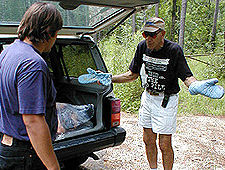 I ask Jacky about future projects with Herschell while we wait for the sun to peek out from the clouds. He tells me he’s secured a five-picture contract with Lewis and hopes to begin the next project in December 2001 if all goes their way. Just about then, a car slowly comes toward what must seem like a macabre sight. Jimi Woods bounds up to the vehicle and cordially suggests an alternate route. Then the sun beams bright and action is called. Fuad hits his mark, steps out of the truck and dumps the body beautifully. Back to the house.
I ask Jacky about future projects with Herschell while we wait for the sun to peek out from the clouds. He tells me he’s secured a five-picture contract with Lewis and hopes to begin the next project in December 2001 if all goes their way. Just about then, a car slowly comes toward what must seem like a macabre sight. Jimi Woods bounds up to the vehicle and cordially suggests an alternate route. Then the sun beams bright and action is called. Fuad hits his mark, steps out of the truck and dumps the body beautifully. Back to the house.
3:45 p.m.
Production manager Brian Pitt has a problem. He tells Herschell that the actress in the next scene has a contract which is very specific about pubic hair. None can appear on screen. This piques the interest of Friedman who weighs in as they discuss the scene in which the girl will strip as she walks up the stairs and into the bathroom. Will she wear panties? If so, a g-string? At what point will each article of clothing be removed? It’s a priceless debate. Herschell says, “I feel the picture would play just as well if we had no nudity, but others don’t feel that way.” A chivalrous remark, for certain, but if there’s to be nekkidness, he’s clearly against false modesty. Friedman is less diplomatic, “I once did a casting call for 600 girls who would do nudity — and got 800! What sort of movie does this girl think she’s making, anyway?!” The two pals then sit down for a quick game of gin rummy while the crew make final preparations.
5:30 p.m.
Well, ANOTHER part of the pube-phobic actress’ contract calls for a closed set, which means the likes of me — the leering press — ain’t welcome. I’m not bitter, though, as I know Fuad has plans for her. Speaking of Fuad, he’s a changed man today. A smiling picture of relaxation. “Looking back on [last night], I wish I’d bit my tongue,” he says of his meltdown moment.
6:00 p.m.
Herschell comes out to the production van to see what the delay is on a critical prop. He looks at me and just shrugs. I while away my wait time with Chris Mauer who not only invested in the picture, but also appears throughout the film as Mr. Lampley — that is, the late Mr. Lampley. Mauer began his career as a political animal, even serving under the illustrious Louisiana governor Edwin Edwards, but then went into financial planning. Today, it seems, the movie bug has bitten. He’s stunned when I explain that it has become infinitely more difficult for a film of this nature to play in theaters than it ever was in the ’60s and early ’70s when Lewis originally made his pictures. At present, the game is home video, as the big studios and the dreaded MPAA have stacked the deck against independent cinema. He looks disappointed, so I remind him that the nation’s art house theaters have become the last sanctuaries of cult features. Chances are good Blood Feast 2 will screen theatrically at such venues, and certainly among the world’s genre festivals.
7:15 p.m.
I’m finally allowed back on set, but feel as timid as a Labrador who’s been tossed out on its ear for whizzing on a Persian rug. My shame passes as I realize they’re going to spend the rest of the evening on gore footage. Joe Castro has whipped up a bloodied mixture of mashed potatoes and Popeye’s fried chicken from last night’s craft service menu, which he intends to use as coed brain matter. The camera rolls and Fuad REALLY gets into his butchery. He grunts and snarls as the gore flows until cut is called. Then Herschell asks him, “What are you going to tell your wife you did today?” Everyone laughs. But J.P. is quite serious when he responds by saying he’s been faced with that quandary before, when he had to explain to his daughter about his playing a racist in a stage version of To Kill A Mockingbird. “[She] wants to know when I’m going to play a nice guy,” he said. It strikes me as a very sensitive response for a man portraying a homicidal maniac.
Looking down at the balled-up glop on the floor, Herschell pauses while instructing the camera crew where to set up, “If we shoot it like that we won’t have a focal problem, but looking at THAT, we might have a fecal problem.” I am the only one who snickers at his word play. He then dubs me “the literate one.”
10:00 p.m.
While the crew begins the 15-minute reset dance that never takes just 15 minutes, I join Herschell at the kitchen table where script supervisor Emily Pendas tells us she believes the picture is 75 percent completed. Excellent news.
What has repeatedly struck me about my time on set is how clearly frustrated both Lewis and Friedman are by seemingly constant delays between shooting scenes. During my initial interview, Lewis told me with great pride about how he and Dave had made The Adventures of Lucky Pierre as a two-man team. And more-or-less that’s how the majority of their pictures were done. Skeletal, efficient crews. They were guerrilla filmmakers before anyone ever bothered to coin the term. No time was spent endlessly adjusting the lighting. Third takes were absolute luxuries and painfully rare in this gun and run era. Their priorities were entirely different than those of the comparatively meticulous young people they’re working with today. Herschell’s filmmaking philosophy favors raw impact over aesthetics, which must seem ridiculous to this generation. I have watched the camera guys roll their eyes when pushed by Lewis to start rolling, when they woud prefer another few minutes to better frame the scene to their liking. Hypothetically, they’d be concerned about a glimmer in the background, while Lewis would contend the audience will be far to enthralled by the bloody knife lunging toward the screen to even notice. He’d be right, of course. So, I ask him about this two-day wrestling match I’ve observed. “I really have to resist my urge to just grab that camera and shoot it myself!,” he confides. “That’s a Panavision with a Mitchell movement. I’ve put millions of feet of film through Mitchells.” He then jokingly describes such repeated, lurching delays as an example of Parkinson’s Law of Expanding Time. Once again, I’m the only one who laughs.
Herschell notices J.P. is at the sink washing dishes. He asks the young man what he’s doing, who tells him he’s just helping out the craft service folks. Lewis is impressed, “I think that’s really VERY nice!” Such displays of teamwork go a long way with Herschell. Take the late Bill Kerwin who starred in many Lewis films. He was a solid actor with a leading man’s screen presence, but more than any other compliment, Herschell commends the actor’s willingness to lug around heavy lighting cables when called upon. It’s a telling distinction.
10:30 p.m.
I’m being eaten alive by mosquitos the size of Ms. Hundie’s implants. We’ve moved outside the house where Detectives Myers and Loomis have some dialogue before entering the apartment. Everyone is hopping from one bare leg to another, slapping themselves in a futile attempt to kill the swarming insects. Everyone except Jacky Morgan who somehow appears to be off the menu.
Midnight
We’re back inside and Castro has assembled the gruesome ingredients for another gore sequence. “I want to do something a little different with each effect,” he tells us. “Otherwise, it starts to lose its impact.” Sounds to me like he puts a lot of thought into such things. Who knew? Soon the familiar whir of an electric carving knife begins and my inner gorehound does cartwheels. Lewis is tickled also. His direction usually demands MORE of whatever carnage is taking place. I remember him asking, quite seriously, “Do I have your solemn word that when you cut, blood will ooze out?”
1 a.m.
My visit is drawing to an end. The experience has far exceeded my giddy imaginings of what it would be like to witness my B-heros in action. It’s only appropriate that the last scene I’ll get to see documents one of Fuad’s more grotesque atrocities. The camera has tightly framed the eyes of his victim. Herschell prods the crew to begin rolling, but they stall once again. Castro’s latex head doesn’t quite match the tanned skin of the actress it’s meant to duplicate. “We’re fighting windmills here,” Lewis barks. “Her whole face will be covered in blood anyway.” They don’t listen and continue to apply makeup. Finally, they’re ready. Castro doubles for Fuad. While his assistant Johnathan Thornton readies two syringes filled with blood that are connected to tubes which run under the head and up into the eye sockets. Lewis and Friedman have crowded around the video monitor when action is called. What transpires is literally breathtaking. Gouts of blood and glop boil upward as Fuad digs a melon baller into each socket popping out the poor girl’s peepers with painful imprecision. Everyone in the room groans. And at this pinnacle of fevered depravity, Friedman slaps Lewis on the back and crows, “GLORIOUS!!!” His celebration is met with nervous laughter from the crew, but not from me. It was glorious indeed, Mr. Friedman.



